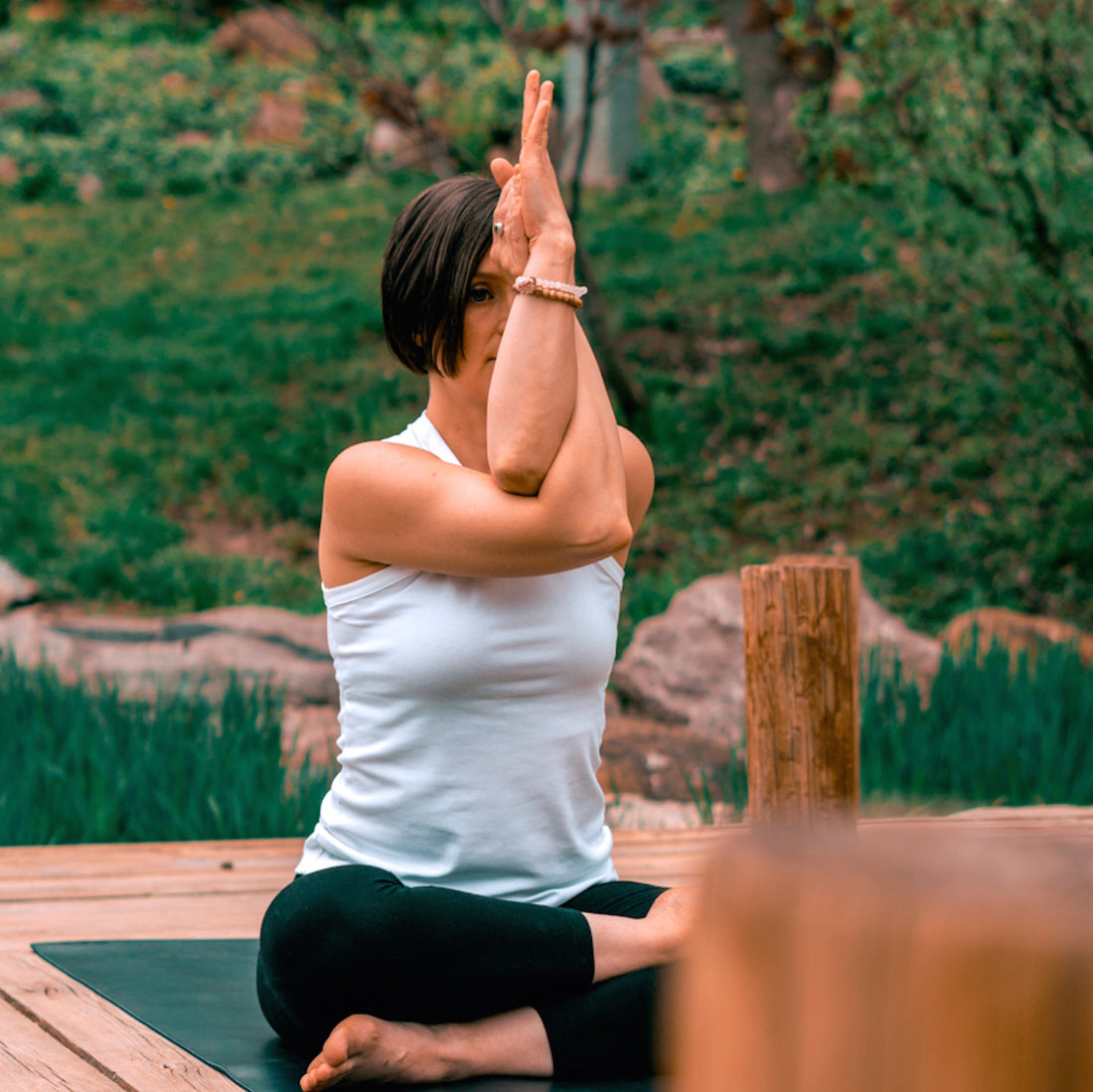
Modern yoga taught at trendy yoga studios and gyms or even a quick search on YouTube for yoga videos often come up with classes like “yoga for your booty,” “yoga for abs,” “yoga for a flexible spine,” “yoga for a flat stomach,” and so forth. While it is true that practicing the physical part of yoga is great for keeping yourself healthy, it is only a small portion of what yoga is and has been for thousands of years.
"You cannot always control what goes on outside. But you can always control what goes on inside." - Unknown
Yoga is a practice, study, and discipline of quieting the mind to become closer to the higher self or consciousness. It has Vedic roots in Hinduism but has also been adopted by Buddhists, Jains, Sufis, and other religions and spiritual seekers. Although not a religion in itself, yoga can be a path towards a spiritual life that can give you so much more benefits than stretching on your mat.
There is a misconception that to practice yoga as a spiritual path, you need to turn away from modern life and live in the forest like the ancient Rishis of India, or forsake the material world and live in a monastery meditating all day like a monk. While this may be the appropriate calling for some people, for others, it doesn't have to be that way.
Many yogic texts even describe different sadhanas, or spiritual practices, to suit what kind of practitioner you are: i.e. A yogic disciple who has moved away from their former life in order to dedicate their life to practice, or even a householder who continues to live with a job, a family, and other obligations.
My path currently includes this daily sadhana: Ideally, every morning, I practice my kriyas and pranayama for purification and cleansing, asana as a check-in on my body and to prepare it physically and mentally for stillness, and a few minutes of meditation. This is my personal commitment to set aside time for my spiritual practice. Admittedly, I'm not always able to do this consistently or with the same amount of enthusiasm all the time, but that is why yoga is a practice for me. A practice where it's ok to take it easy on myself and others whenever needed.
Your sadhana may look completely different from mine. Your spiritual life is your personal relationship with whatever you believe the Divine to be. Yoga can be a wonderful tool to help keep you steady on this path – and it has the energies of possibly 10 thousand years of spiritual seekers behind it to support your way.
5 Tips To Keep Your Yoga Practice Spiritual
It's not about the Pose, it's about the Breath
Patanjali, the Vedic sage who is credited as the compiler of the Yoga Sutras which is the basis for the 8 Limbs of Yoga most modern schools follow, only had two verses among 196 which spoke specifically about asana. One of which is verse 2.46 on its definition:
sthira sikham asanam
Which roughly translates as, “the posture should be steady and comfortable.” In other words, in every asana, should be a balance of strength and ease. You can keep a check on this, primarily by ensuring that you can still breath easily no matter what pose you are in."
Sri T. Krishnamacharya, who is known as the father of modern yoga, emphasized breath as the most important part of a yogasana practice. The movement should follow the breath and breathing itself becomes a spiritual act:
“Inhale, and God approaches you.
Hold the inhalation, and God remains with you.
Exhale, and you approach God.
Hold the exhalation, and surrender to God.”
-Krishnamacharya
One of Krishnamacharya's students, B.K.S. Iyengar, who established one of the most popular yoga styles today, has written that the true path of yoga is towards the soul:
“Yoga practice [guides] the mind towards its source, which is the core of being — atman (the soul), or purusha (Self).”
Meditate on the Meaning of Namaste
One of the first times the western world was acquainted with the word namaste was when India gained its independence from British colonial rule in the mid-20th century. The newly appointed leader, Jawaharlal Nehru, reportedly used the namaskar mudra, with his palms in prayer in front of his chest often, and this was written about in the American and British press at the time. (https://www.merriam-webster.com/words-at-play/the-history-of-namaste)
Today, namaste has entered the English dictionary and is often said at the beginning and end of many yoga classes. Even those who do not practice yoga recognize the word and it's hand gesture. But if you go back to the meaning of this word and mudra, it can help to enrich your spiritual life just as much as a 20 minute meditation or one hour asana class.
Namaste is an acknowledgement of one soul's divine nature to another. In Sanskrit, this single word can have multiple meanings:
- The light in me honours the light in you.
- I bow to the divine in you.
- The sacred in me recognizes the sacred in you.
So every time you say this word or perform this mudra with your hands in front of your chest, remember that you are recognizing and bowing to the atman, the divine universal soul, in every being.
Practice with Tapas - “burning enthusiasm”
Tapasya, or Tapas as it is more commonly called, is the third of the five Niyamas outline by Patanjali in the Yoga Sutras. The literal translation of this Sankrit word is “heat” and is often defined as austerity or self-discipline. Some take tapas to the extreme with fasting or other enormous physical feats like standing on one leg for years. But your tapas can be a very personal practice as long as it is done with the intention of preparing yourself to reach your true potential.
Swami Satchidananda, aka the Woodstock Guru, said that “tapas is self-discipline, not self-torture. It is right effort, not more effort.”
Living within the structure of Tapas, can help us make changes in our lives. Our efforts no longer become about ourselves, but our Greater Selves and our ultimate aim to be that. Through yogasana and other spiritual practices, we stroke a fire in ourselves that drive us to not only go against the habits of the world but also the habits that have been conditioned in us.
SOURCES:
https://yogashanti.com/focus/tapas-riding-the-heat/#.XfOyQugzY2w
Take it off the Mat
As you may probably already know, yoga doesn't stop when you roll up your mat. It's about living in union with yourself and the whole universe. It's very often explained that the Sanskrit origin of the word yoga means “to yoke together” or “to unite.” And this is what all the practices of yoga are really all about – uniting with atman – the source of all.
Your personal belief of what atman is will help you determine how to maintain your yoga practice off the mat. Because atman, no matter what word or name you use to describe what it is for you, is everywhere. Interestingly, according to Tantra author David Frawley, the word atmosphere, also has origins in this Sanskrit word. Just another reminder that this universal power is indeed above, around, and sustains us.
Never Stop Learning
One of the best things you can do to practice yoga as a spiritual path is to never stop being a student. Even if you've been at this for years. Even if you've been to ten 200-hour teacher trainings. Even if you've been blessed with a spiritual name from a sadhu in India. Keep an open mind and never stop learning.
In the past, the guru and student/disciple relationship was integral to the yoga practitioner to become a yogi. But these days, its difficult to find a true guru who has the spiritual life of their students at heart. Fortunately, even though much of yoga is passed down through oral tradition, hence the importance of an authentic guru, many have been breaking away from this tradition and writing books about their teachings or giving permission to their students to write books for them.
These books are valuable for those of us who would like to learn from these teachers but are unable to travel through time and space to study with them directly. Their books and recorded lectures allow us to learn more even without being in their physical presence.
But even if you find a teacher, in person or through books and other learning formats, practice your own discernment too. In the end, you are your own best guru and no one knows your body, mind, your relationship to spirituality and the Divine, and your highest potential better than you. Trust that and you will learn so much more from your inner guru.
Final Words
One of the things I love about yoga is even though it's a system that is more than 10 thousand years old, it's not a one size fits all practice. Probably one of the reasons why it has lasted so long and has appealed to so many spiritual seekers is because it allows everyone's personal beliefs and backgrounds to use it as a tool for spiritual enlightenment and liberation.
So much more than a way to stay fit – although that is a very real and positive bonus of a regular yoga practice – it is also a spiritual path that can help you reach your highest potential. By learning about and going back to the roots of yoga, you can find a discipline that not only works for you, but will also bring you joy every time you practice.
SOURCES:
https://chopra.com/articles/how-to-live-your-sadhana-every-day
https://yogastlouis.us/provenance-where-does-yoga-asana-come-from/
http://www.spiritualworld.org/yoga/print.htm
 Article Guest Written By Jan Diwata who is a travelling yoga teacher and innerdance facilitator. She has held space for immersions and workshops across Asia, Canada, the Middle East, and Europe. She continues to deepen her knowledge and practice of yoga, not only as a physical exercise, but as a spiritual path and incorporates her learnings with her roots in the ancestral wisdom from her Philippine heritage of healing and connection to the Divine. She is available for bookings anywhere in the world. Connect with Jan over at http://www.jandiwata.com. Read more of Jan's articles on The OM Collective here>>>
Article Guest Written By Jan Diwata who is a travelling yoga teacher and innerdance facilitator. She has held space for immersions and workshops across Asia, Canada, the Middle East, and Europe. She continues to deepen her knowledge and practice of yoga, not only as a physical exercise, but as a spiritual path and incorporates her learnings with her roots in the ancestral wisdom from her Philippine heritage of healing and connection to the Divine. She is available for bookings anywhere in the world. Connect with Jan over at http://www.jandiwata.com. Read more of Jan's articles on The OM Collective here>>>

